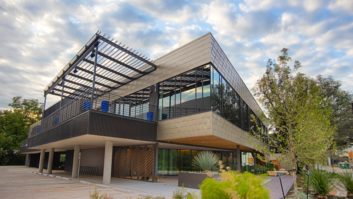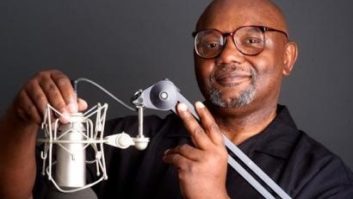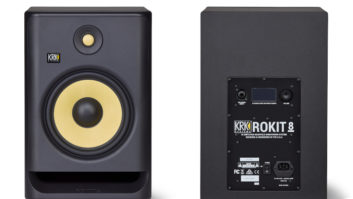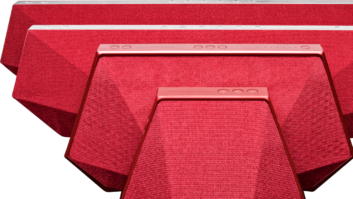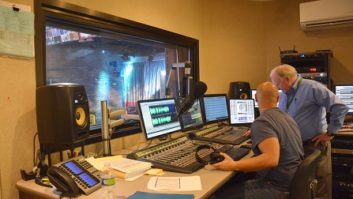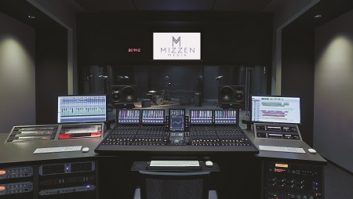As a radio broadcast consultant, one of the best parts of my job is coaching air talent.
Lately a lot of them are working from home. And since broadcasters are creative wherever they are, it’s been fun (and an eye-opener) to have a chance to work with many of them in their home studios.
If you’ve been around long enough, you may remember the old days. That’s when home studios were installed by stations at great cost — to increase broadcast options for the talent. The studio-in-your-house allowed TV meteorologists to do live weather reports for morning drive and pregnant hosts on bed rest (or otherwise unable to get into work) or those ready to retire to broadcast from home. Management could easily “extend the franchise” if certain personalities could work from their golf condos.

Barbara Blake’s home studio shows her personal touch.
But now, as Lee Harris, president of Harris Media and morning anchor of New York City’s 1010 WINS(AM) puts it, “It’s absurd how easy and inexpensive home studios are, especially if you remember when the closest thing to a radio station computer was a Schafer 800 automation system with clacking relays and thumbwheels for sequencing the events.”
With proliferating connection options and the decreasing price of quality sound and video equipment, broadcasters are turning bedrooms, garages, even tree houses into air-worthy studios. Do-it-yourself home studios can produce state-of-the-art audio with a laptop, digital recorder, a mixer and a couple of good microphones. But if you’re a broadcast engineer and you haven’t already been asked, it’s likely that someday soon, somebody will ask you for help with his or her home studio.
So here’s a peek behind the not-so-soundproof doors of three air personalities with home studios that work for them.
Stu w/Vu
Barbara Blake, owner of Citizen Planet Productions, has broadcast for Los Angeles station KTWV(FM) and San Francisco’s KKJZ(AM) and KKSF(FM) for more than 15 years. For much of that time, she has also voice-tracked for other stations outside her home market.
Her take: “Until recently, ‘home studio’ meant black egg crate foam sound-proofing, a decent mic and a Mackie board — enough for voice-tracks, spots and voiceovers. Under the headphones I could hear a plane coming in and just waited until it passed.
“Then I decided to fulfill my dream of being an online broadcast entrepreneur. Now, a large room with views of the Pacific Ocean is dedicated to my business. It’s a visually enticing, broadcast-quality space, reflecting my personality and aesthetic.”
Part of that environment includes Blake’s three cats, who understand the meaning of “Quiet!” and like to hang out in her studio.

Lee Harris is about to step into his closet-based home studio.

Blake set up her studio with design help from professionals. That really paid off, she said.
“My collaboration with engineer Ali Sater of CBS L.A. was a joy. Once I knew what I wanted, the Internet and craigslist saved me 30–40 percent on everything — except that Manley Reference Cardioid Mic I still lust for.
“I love my Avalon 737 preamp, with (Audio-Technica) AT4050 and Sennheiser 416 shotgun mics. On phone interviews, I use the JK Audio innkeeper 1x, for remote interviews, a Marantz PMD660 portable digital recorder and a Sennheiser MKH 416 mic. It’s all run through a Mackie 1402-VLZ Pro board to my PC. I use a PC for recording and editing.”
She added: “Here’s how I dressed the studio for her close-up: mineral wool board and eight feet of soundproofing sheets, sheathed with fabric, installed inside and outside the closet area; a ceiling rod track holds sound sheets. Those expanded my workspace by 20 square feet! An antique desk and shelving on either side of a hydraulic chair accommodate more gear.”
But like any contemporary broadcaster, Blake had to develop an Internet presence. She said: “I use a Mac for Web design and graphics. SmoothJazzSundayBrunch.com is my initial project, with more to come.”
Money-maker

Turi Ryder’s home studio looks comfortable and has its own go-fer. Lee Harris has turned his home studio into money-maker.
“Since I do morning drive, occasionally spots come in later in the day. My home studio allows me to turn it, and anything else that comes down the pipe, around in pretty short order, with sound as good as I get at the station.”
His description of the operation: “My Manhattan apartment studio-in-a-closet consists of a mic, a Shure USB A/D converter and a Macbook Pro running the new Mac version of (Adobe) Audition, replacing Pro Tools. I set it up as needed, and break it down when I’m done. I use my iPad for reading scripts, and do post-production outside the closet on a PC running Audition.”
As with most any broadcast endeavor, the microphone gets the most attention.
“My microphones include a Neumann U 87, EV RE27, RCA 77DX and an Audio-Technica AT2020 USB mic. I switch between them depending on the projects. The RCA runs through a PreSonus tube preamp, but I’m looking for something a little more vintage. On the road I record on my iPad using the AT2020 running into the Apple iPad Camera Connection kit. It works well with a podcasting app called ’Caster.’”
Budget-conscious
Content creator and radio personality Turi Ryder owns Shebops Productions. She produces her “Exception to the Rule” feature for CBS Radio news from her home studio.
Under a hanging dinosaur (a gift from a listener), she broadcasts there for stations like KIRO(AM) Seattle, WMAL(AM) Washington and WLS(AM/FM) Chicago — visited frequently by her German Shepherd, Sasha.
“Since I work via ISDN, my most necessary ingredient is a Telos Zephyr codec. I like to have two of everything. You never want to say, ‘Sorry, technical difficulties.’”
Ryder’s San Francisco studio was built by friends she’s known since her high school radio station days. Michael Englehaupt, head of broadcast engineering at KPIX(TV), and Tom Demos, owner of Portland Media Monitor, helped with a “shopping list.”
“I had to remind them my budget was smaller than a ‘real’ station’s.”
For engineering troubleshooting, Ryder said, “Tom’s virtually networked to my computer, so for questions I virtually ‘show’ him the problem using online schematics.”
One of the challenges of a home studio is soundproofing.
Ryder said, “My studio’s sound isolation is good, not perfect. But, at ‘Free FM’ here, we had a huge window overlooking a major thoroughfare. Whenever a truck climbed the hill outside, you could hear it. Years ago, that would have been unacceptable. Now, it adds ambience.
“I did worry when I hosted one Fourth of July for KIRO. My neighbors go nuts with firecrackers. But KIRO’s main studios are about a block from the base of Seattle’s fireworks, so my home studio was actually quieter than what I could hear in the talkback.”
Another fringe benefit when you build a home studio for someone: improved respect and understanding of what your engineering department does every day. Adds Ryder, “Now, I’m much more careful where I put my coffee cup.”
Careful!
Of course nothing is ever perfect and there is such a thing as getting too comfortable when you broadcast from home.
A cautionary tale is the story of one former weekend program host at KGO(AM) in San Francisco. He liked to use a wireless microphone headset for his shows and wander through his house while on the air or during breaks. Unfortunately, there’s no “on air” light in your kitchen, and a careless phrase meant for the host’s producer went over the airwaves, costing him his job.
The author is a broadcast consultant, speaker, workshop leader and talent coach. Her book “Beyond Powerful Radio — A Communicator’s Guide to the Internet Age” is available from Focal Press.






